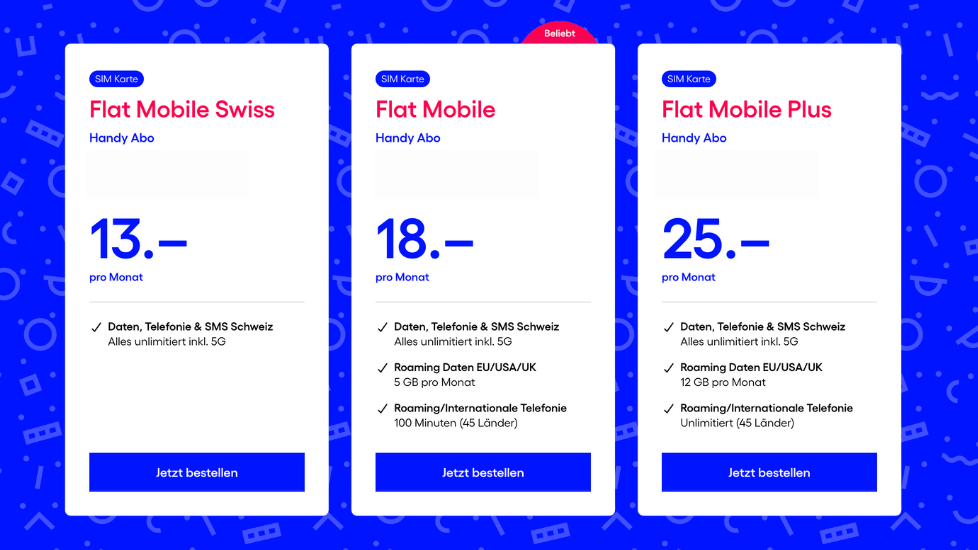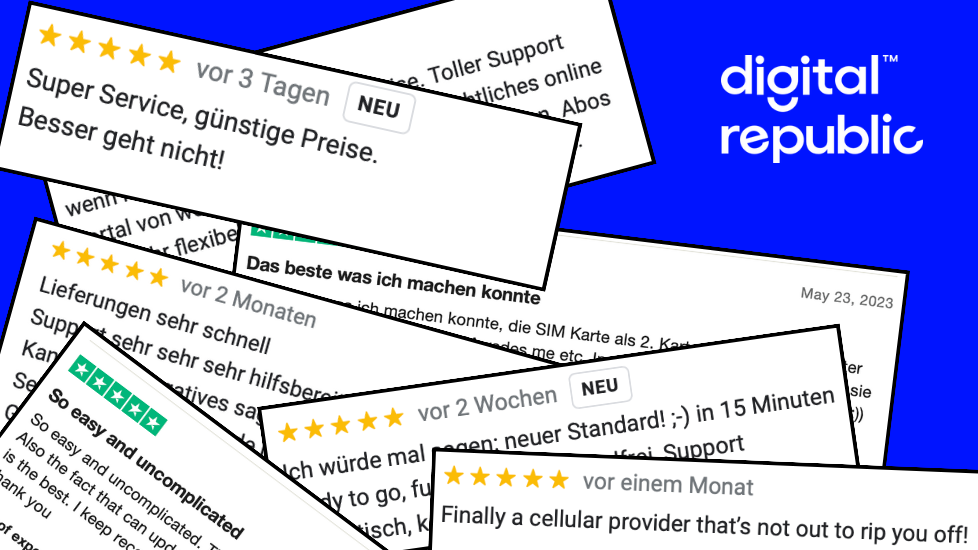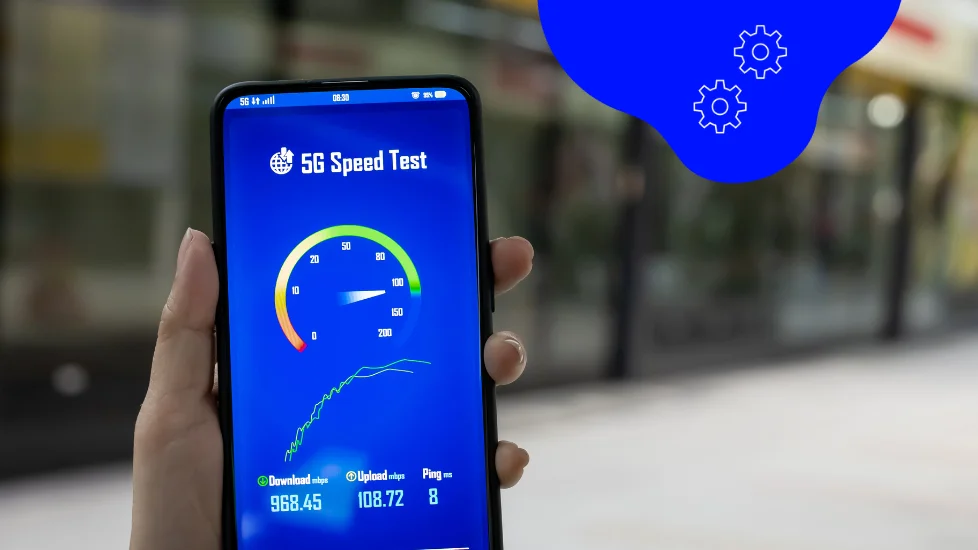Mobile internet for everyone and everything
The Ultimate eSIM Guide: Everything You Need to Know About eSIMs!
Last updated on January 29, 2025
The eSIM will replace the classic SIM card. So it’s time to think about the eSIM and answer any questions you may have. As an eSIM provider from the very beginning, Digital Republic has a wealth of expertise to share!
Table of Contents
1. What Is an eSIM?
An eSIM, or “embedded SIM,” is basically nothing more than a small chip that is permanently soldered into many newer smartphones. This chip can store the information that would normally be stored on a conventional SIM card.
Using an eSIM makes registering with mobile carriers much easier and less complicated, but that’s not all! eSIMs also enable devices to be built more compactly and densely.
2. What Does “eSIM” Mean and How Does It Work?
The abbreviation “eSIM” stands for “embedded subscriber identity module”. The subscriber identity module (SIM) identifies you in your provider’s network and allows you to assign and bill your mobile connection. In this case, “embedded” means that the SIM does not sit on a piece of plastic like a SIM card, but is soldered directly into the end device, such as your smartphone.
Among other things, a unique IMSI number is stored on the chip, which is then assigned to you as a customer when you activate the eSIM. This enables your provider to assign the SIM to your customer account and bill you for its services. In functional terms, the eSIM is nothing more than a SIM card that is permanently installed in your device and can be provided with profiles from different providers.

3. What Are the Advantages of an eSIM?
Convenience: You can easily switch between carriers and plans without changing your SIM card. There’s also no shipping time, so you can activate a new eSIM in minutes without having to go to a store.
Security: eSIMs are more secure than physical SIM cards because they are less likely to be lost or damaged. The latest security standards for the transmission of eSIM profiles also prevent malware from being installed on your smartphone via an eSIM QR code.
International travel: eSIMs make it easy to use your phone in different countries, as you can simply download a new mobile operator profile when you arrive. This way, you can avoid expensive roaming and simply use a local plan instead. As a Digital Republic customer, you can activate a profile like this directly with us using the Travel eSIM. This way, you can easily and cheaply stay online even outside the roaming zone included in your Flat Mobile rate.
More compact devices: Smartphones without a SIM slot lose another opening in the casing and offer more internal space for memory or battery. This makes eSIM devices more compact and more sealed against dust and water.
Sustainability: the eSIM makes it possible to dispense with traditional SIM cards, which no longer need to be manufactured and shipped. This makes the eSIM, as a digital product, much more sustainable than the traditional plastic SIM card.
4. Which Devices Support the eSIM?
Many newer smartphones and tablets already support eSIM. If you want to find out whether your device is eSIM-capable, simply check the settings. If you can find an option for adding an eSIM under the settings for “Cellular”, “Calls”, “SIM cards” or similar, your device is eSIM-capable.
Alternatively, you can simply try scanning the eSIM code of a friend or of our Travel eSIM. If your smartphone recognizes the link as an eSIM and lets you add a new mobile plan, it is also eSIM-enabled. By the way, most online shops also let you filter the listed devices by SIM type. So if you are looking for an eSIM smartphone or tablet, it’s worth taking a look at the filters.
5. Where Can I Get an eSIM in Switzerland?
Most Swiss providers also offer eSIM rates. Unfortunately, the providers differ quite a bit in terms of activation fees, contract terms, and the ordering process. Some providers even sell the eSIM in a physical store.
“There you buy a cardboard card on which the QR code for the eSIM is printed. It’s completely beyond me how you can come up with such a process.
– Ralf Beyeler, telecom expert at moneyland.chI wonder what the product managers were smoking when they developed these processes, that they don’t sell a completely digital product over the internet, but in physical stores.”
The Digital Republic eSIM is easy to order via the customer portal and can be activated by you in minutes. The following video shows you how easy it is to do this. And since Digital Republic has no activation fees or minimum contract term, the Digital Republic eSIM is also a great way to simply test this new technology for a month. Why not take a look right now!

6. How Secure Is the eSIM?
The eSIM serves the same purpose as a physical SIM and also offers the same basic security precautions such as PIN and PUK. In addition, communication with the server that provides your eSIM is secured by GSMA standards. You can read more about this in this article.
The eSIM is considered more secure than the physical SIM because it cannot be removed from the device, stolen or tampered with. As long as you are in possession of your smartphone, your eSIM is also safe.
7. How Do I Activate an eSIM?
Activating an eSIM is child’s play! Provided, of course, you have an eSIM-enabled device. With most newer devices, all you need to do is scan the QR code you receive with the camera app. Your smartphone will then recognize that the code is an eSIM, and it will suggest adding the new mobile plan in a pop-up. However, we are happy to give you a step-by-step guide for the two most popular brands as a rough guide. The steps may vary slightly depending on the manufacturer and model:
On iPhone
- scan the QR code of the eSIM with your camera app
- a message “Mobile plan detected” will appear. Tap the message and then tap “next”
- now select the function “add mobile plan” (if you are asked to enter a confirmation code, enter the number provided by your provider) Done!
On a Samsung smartphone
- open the “Connections” tab in your settings and tap on “SIM card management”
- now tap on “Add mobile plan”
- tap on “Add via QR code”, scan the QR code and then confirm by tapping on “Add” again. Done!
8. How Do I Delete an eSIM?
Of course, you can also remove eSIM profiles from your smartphone, for example, if you need space for another profile or change your provider. Again, the exact steps vary slightly from manufacturer to manufacturer, but you can usually find the corresponding function in the settings under “Mobile Network” or “Network & Internet”:
On an iPhone or iPad
- go to your settings from the home screen
- tap on “Mobile network”
- under “Mobile plans” select the eSIM profile you want to delete
- tap on “Remove mobile plan”
On an Android smartphone
- go to your settings via the app drawer
- tap on “Network & Internet” and then on “Mobile network”, then tap on “Expanded”, “eSIM profile”
- tap on “Advanced” and then on “Cellular service provider
- tap on the settings icon next to the profile you want to delete and then tap on “Delete”
- confirm the deletion in the popup
9. Can the eSIM Also Be Used for Roaming?
The eSIM works just like a traditional SIM card. You can therefore also use roaming packages when you are on the road. Roaming is only deactivated by default on certain devices, such as the Apple Watch, for cost protection reasons.
With the eSIM, you also have the advantage that you can easily load an eSIM from a local provider onto your smartphone when you are abroad. For many countries, there are also special eSIM roaming providers such as Airalo or Truphone. This can save you a lot of money compared to classic roaming, depending on the zone. Digital Republic recommends using roaming packages primarily in zone 1 (EU/USA) and using local providers or a travel eSIM for the more expensive zones.
10. What Comes After the eSIM?
The eSIM will replace the classic SIM card, that much is certain. What comes after the eSIM is also already known, but you as users will probably not notice much about it. While the eSIM is still installed as a separate chip in the device, the successor to the eSIM is already an integral part of the processor chip.
In the context of newer SoC (System on a Chip) architectures, the SIM is stored directly in the SoC. This new form of SIM is called “iSIM” or “integrated SIM”. The iSIM is also expected to be loaded onto the device via a QR code and will include the same functions as the eSIM. You can find out more about the iSIM and the development of the SIM in this article.
Want to Know More?
If you’ve read this far and want to learn more about eSIM, take a look at esim.ch! On this page, we collect and publish news about the development of eSIM and answer further questions you may have about the technology and use of eSIM.
Discover Our Other News Articles

The Development of Our Ideal Cell Phone Plans for Switzerland
The path to the current Trio Flat Mobile Swiss, Flat Mobile, and Flat Mobile Plus cell phone plans is also an example of how Digital Republic wants to function as a provider and where its priorities lie. We have quickly transformed ourselves from a pure data SIM provider to a cell phone plan provider. And we have completely rethought the development process.

The Affordable Mobile Provider With Award-Winning Service
When it comes to mobile providers in Switzerland, the wheat is often separated from the chaff when it comes to price. Either you pay little for your subscription and do without services like support or 5G, or you go to one of the big providers and pay more than you might like. At Digital Republic, you get both!

Why 5G Is Not Always Equally Fast
Sometimes fast, sometimes slow, sometimes suddenly 4G again. The network indicator on your smartphone suggests that it is connected to the internet via either 4G or 5G. In fact, a complex mechanism and a lot of communication between your smartphone and the network is taking place in the background to ensure that you always have the best possible connection.
